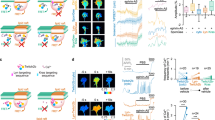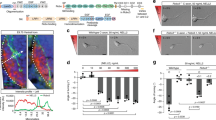Abstract
Growing axons navigate by responding to chemical guidance cues. Here we report that growth cones of rat cerebellar axons in culture turned away from a gradient of SDF-1, a chemokine that attracts migrating leukocytes and cerebellar granule cells via a G protein–coupled receptor (GPCR). Similarly, Xenopus spinal growth cones turned away from a gradient of baclofen, an agonist of the GABAB receptor. This response was mediated by Gi and subsequent activation of phospholipase C (PLC), which triggered two pathways: protein kinase C (PKC) led to repulsion, and inositol 1,4,5-triphosphate (IP3) receptor activation led to attractive turning. Under normal culture conditions, PKC-dependent repulsion dominated, but the repulsion could be converted to attraction by inhibiting PKC or by elevating cytosolic cGMP. Thus, GPCRs can mediate both repulsive and attractive axon guidance in vitro, and chemokines may serve as guidance cues for axon pathfinding.
This is a preview of subscription content, access via your institution
Access options
Subscribe to this journal
Receive 12 print issues and online access
$209.00 per year
only $17.42 per issue
Buy this article
- Purchase on Springer Link
- Instant access to full article PDF
Prices may be subject to local taxes which are calculated during checkout






Similar content being viewed by others
References
Tessier-Lavigne, M. & Goodman, C.S. The molecular biology of axon guidance. Science 274, 1123–1133 (1996).
Song, H.J. & Poo, M-m. Cell biology of neuronal navigation. Nat. Cell Biol. 3, 93–98 (2001).
Flanagan, J.G. & Vanderhaeghen, P. The ephrins and Eph receptors in neural development. Annu. Rev. Neurosci. 21, 309–345 (1998).
Mueller, B.K. Growth cone guidance: first steps towards a deeper understanding. Annu. Rev. Neurosci. 22, 351–388 (1999).
Raper, J.A. Semaphorins and their receptors in vertebrates and invertebrates. Curr. Opin. Neurobiol. 10, 88–94 (2000).
Yu, T.W. & Bargmann, C.I. Dynamic regulation of axon guidance. Nat. Neurosci. 4, 1169–1176 (2001).
Wu, W. et al. Directional guidance of neuronal migration in the olfactory system by the secreted protein Slit. Nature 400, 331–336 (1999).
Yee, K.T., Simon, H.H., Tessier-Lavigne, M. & O'Leary, D.M. Extension of long leading processes and neuronal migration in the mammalian brain directed by the chemoattractant netrin-1. Neuron 24 607–622 (1999).
Zou, Y.R., Kottmann, A.H., Kuroda, M., Taniuchi, I. & Littman, D.R. Function of the chemokine receptor CXCR4 in haematopoiesis and in cerebellar development. Nature 393, 595–599 (1998).
Ma, Q. et al. Impaired B-lymphopoiesis, myelopoiesis, and derailed cerebellar neuron migration in CXCR4- and SDF-1-deficient mice. Proc. Natl. Acad. Sci. USA 95, 9448–9453 (1998).
Murphy, P.M. The molecular biology of leukocyte chemoattractant receptors. Annu. Rev. Immunol. 12, 593–633 (1994).
Devreotes, P.N. & Zigmond, S.H. Chemotaxis in eukaryotic cells: a focus on leukocytes and Dictyostelium. Annu. Rev. Cell Biol. 4, 649–686 (1988).
Bleul, C.C., Fuhlbrigge, R.C., Casasnovas, J.M., Aiuti, A. & Springer, T.A. A highly efficacious lymphocyte chemoattractant, stromal cell-derived factor 1 (SDF-1). J. Exp. Med. 184, 1101–1109 (1996).
Oberlin, E. et al. The CXC chemokine SDF-1 is the ligand for LESTR/fusin and prevents infection by T-cell-line-adapted HIV-1. Nature 382, 833–835 (1996).
Bleul, C.C. et al. The lymphocyte chemoattractant SDF-1 is a ligand for LESTR/fusin and blocks HIV-1 entry. Nature 382, 829–833 (1996).
Lu, Q., Sun, E., Klein, R.S. & Flanagan, J.G. Ephrin-B reverse signaling is mediated by a novel PDZ-RGS protein and selectively inhibits G protein-coupled chemoattraction. Cell 105, 69–79 (2001).
Klein, R.S. et al. SDF-1 alpha induces chemotaxis and enhances Sonic hedgehog-induced proliferation of cerebellar granule cells. Development 128, 1971–1981 (2001).
Sotsios, Y., Whittaker, G.C., Westwick, J. & Ward, S.G. The CXC chemokine stromal cell-derived factor activates a Gi-coupled phosphoinositide 3-kinase in T lymphocytes. J. Immunol. 163, 5954–5963 (1999).
McGrath, K.E., Koniski, A.D., Maltby, K.M., McGann, J.K. & Palis, J. Embryonic expression and function of the chemokine SDF-1 and its receptor, CXCR4. Dev. Biol. 213, 442–456 (1999).
Igarashi, M., Strittmatter, S.M., Vartanian, T. & Fishman, M.C. Mediation by G proteins of signals that cause collapse of growth cones. Science 259, 77–79 (1993).
Song, H.-j., Ming, G.-I. & Poo, M-m. cAMP-induced switching in turning direction of nerve growth cones. Nature 388, 275–279 (1997).
Song, H.-j. et al. Conversion of neuronal growth cone responses from repulsion to attraction by cyclic nucleotides. Science 281, 1515–1518 (1998).
Hopker, V.H., Shewan, D., Tessier-Lavigne, M., Poo, M-m. & Holt, C. Growth-cone attraction to netrin-1 is converted to repulsion by laminin-1. Nature 401, 69–73 (1999).
Poznansky, M.C. et al. Active movement of T cells away from a chemokine. Nat. Med. 6, 543–567 (2000).
Song, H. & Poo, M-m. Signal transduction underlying growth cone guidance by diffusible factors. Curr. Opin. Neurobiol. 9, 355–363 (1999).
Hong, K., Nishiyama, M., Henley, J., Tessier-Lavigne, M. & Poo, M.M. Calcium signaling in the guidance of nerve growth by netrin-1. Nature 403, 93–98 (2000).
Zheng, J.Q. Turning of nerve growth cones induced by localized increases in intracellular calcium ions. Nature 403, 89–93 (2000).
Berridge, M.J. Neuronal calcium signaling. Neuron 21, 13–26 (1998).
Ming, G.l. et al. Phospholipase C-γ and phosphoinositide 3-kinase mediate cytoplasmic signaling in nerve growth cone guidance. Neuron 23, 139–148 (1999).
Zhou, F.Q. & Cohan, C.S. Growth cone collapse through coincident loss of actin bundles and leading edge actin without actin depolymerization. J. Cell Biol. 153, 1071–1083 (2001).
Wang, J.F., Pack, I.W. & Groopman, J.E. Stromal cell-derived factor-1a stimulates tyrosine phosphorylation of multiple focal adhesion proteins and induces migration of hematopoietic progenitor cells: roles of phosphoinositide-3 kinase and protein kinase C. Blood 95, 2505–2513 (2000).
Berridge, M.J., Downes, C.P. & Hanley, M.R. Neural and developmental actions of lithium: a unifying hypothesis. Cell 59, 411–419 (1989).
Takei, K., Shin, R.M., Inoue, T., Kato, K. & Mikoshiba, K. Regulation of nerve growth mediated by inositol 1, 4,5-trisphosphate receptors in growth cones. Science 282, 1705–1708 (1998).
Meucci, O. et al. Chemokines regulate hippocampal neuronal signaling and gp120 neurotoxicity. Proc. Natl. Acad. Sci. USA 95, 14500–14505 (1998).
Hatten, M.E. Central nervous system neuronal migration. Annu. Rev. Neurosci. 22, 511–539 (1999).
Hesselgesser, J. & Horuk, R. Chemokine and chemokine receptor expression in the central nervous system. J. Neurovirol. 5, 13–26 (1999).
Mennicken, F., Maki, R., de Souza, E.B. & Quirion, R. Chemokines and chemokine receptors in the CNS: a possible role in neuroinflammation and patterning. Trends Pharmacol. Sci. 20, 73–78 (1999).
Xia, M.Q. & Hyman, B.T. Chemokines/chemokine receptors in the central nervous system and Alzheimer's disease. J. Neurovirol. 5, 32–41 (1999).
Campbell, J.J. et al. Chemokines and the arrest of lymphocytes rolling under flow conditions. Science 279, 381–384 (1998).
Wu, J.Y. et al. The neuronal repellent slit inhibits leukocyte chemotaxis induced by chemotactic factors. Nature 410, 948–952 (2001).
Nakamura, F., Kalb, R.G. & Strittmatter, S.M. Molecular basis of semaphorin-mediated axon guidance. J. Neurobiol. 44, 219–229 (2000).
Borghesani, P.R. et al. BDNF stimulates migration of cerebellar granule cells. Development 129, 1435–1442 (2002).
Hatten, M.E. Neuronal regulation of astroglia morphology and proliferation in vitro. J. Cell Biol. 100, 384–396 (1985).
Acknowledgements
This work was supported by grants from the Major State Basic Research Program of China and from the Shanghai Science and Technology Development Foundation.
Author information
Authors and Affiliations
Corresponding author
Ethics declarations
Competing interests
The authors declare no competing financial interests.
Rights and permissions
About this article
Cite this article
Xiang, Y., Li, Y., Zhang, Z. et al. Nerve growth cone guidance mediated by G protein–coupled receptors. Nat Neurosci 5, 843–848 (2002). https://doi.org/10.1038/nn899
Accepted:
Published:
Issue Date:
DOI: https://doi.org/10.1038/nn899



